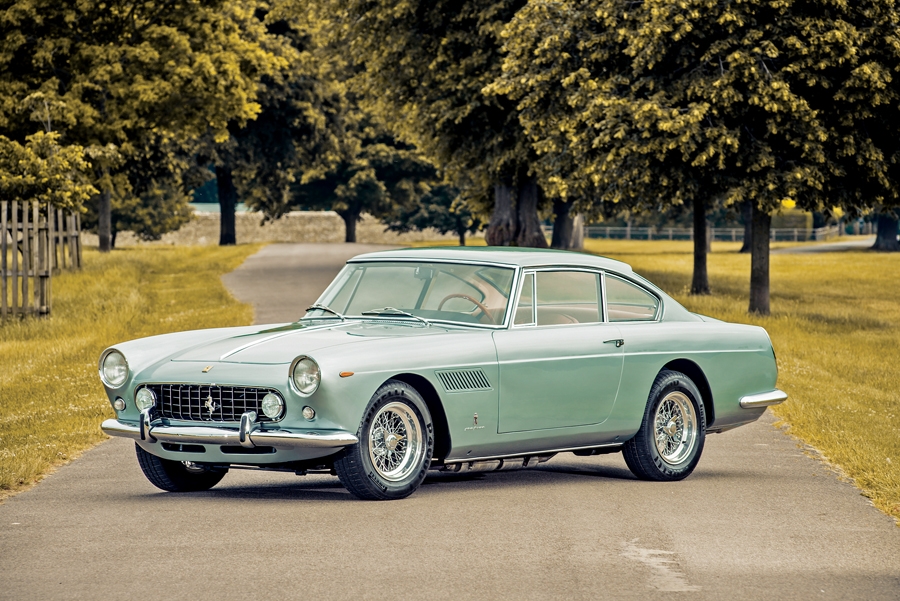SCM Analysis
Detailing
| Vehicle: | 1962 Ferrari 250 GTE Series II 2 2 Coupe |
| Years Produced: | 1960–63 |
| Number Produced: | 954 |
| Original List Price: | $11,000 |
| SCM Valuation: | $225,000–$500,000 |
| Tune Up Cost: | $1,500–$3,500 |
| Distributor Caps: | $350 |
| Chassis Number Location: | Left frame member near steering box |
| Engine Number Location: | Right rear motor mount |
| Club Info: | Ferrari Club of America |
| Website: | http://www.ferrariclubofamerica.org/ |
| Alternatives: | 1959–62 Ferrari 250 Pininfarina coupe, 1963–65 Ferrari 330 2 2, 1966–68 Lamborghini 400GT 2 2 |
| Investment Grade: | C |
This car, Lot 226, sold for $510,911, including buyer’s premium, at Silverstone Auctions’ Salon Privé sale at Blenheim Palace in Oxfordshire, U.K., on September 5, 2015.
The last time SCM covered a 250 GTE was just over three years ago. In my infinite wisdom, I questioned the buyer’s perspicacity in investing $160,000 in a non-running barn find. The price paid was more than the value of a running car and far more than a donor for a re-creation should have been worth. I volunteered that restoring the car was the equivalent of burning money. Perhaps I spoke too soon.
Fewer seats, more money
In the hierarchy of collector cars, four-place and 2+2 models fall well behind in value to two-place models of similar cars. Think Jaguar XKE and XKE 2+2, Lotus Elan and Elan Plus 2, Morgan 4/4 in two- and four-place. I can’t think of a case where a 2+2 is worth more than a two-place model of a similar car. Every $10-million-plus sale in SCM’s Platinum Database is a two-place car. Only a few of the $5-million-plus cars are four-place examples, with two of those being Bugatti Royales. Even the top Mercedes and Duesenbergs are two-place examples.
Interestingly, as new cars, most of the four-place Ferraris were quite popular, often selling better than the two-place models. Ferrari built something like 18 different two-place 250 models, yet the lone 2+2 — the 250 GTE — accounted for nearly 40% of the total 250 production. There were more than twice as many GTEs sold as any other single 250 model. Similarly, the 330 2+2 far outsold the 330 GTC. Other 2+2 Ferraris such as the 365 GT 2+2, 400 and 456 also had impressive sales.
The four-place cars contained more metal, more leather, and often more creature comforts than the two-place cars, which meant they also had higher list prices. It wasn’t until they became used cars that the gift of depreciation made them a bargain in the marketplace. As used cars, the value of a four-place Ferrari is traditionally dwarfed by its contemporary two-seater equivalent.
I’ve counted the reasons why in these pages before, but in a nutshell, looks, performance and condition all play a part in determining the value of a used car. Collectors buy preference over practicality, and they prefer two-seaters. Looks sell, and the two-place cars traditionally look better than the larger four-place cars. The two-place cars also win out in the performance category. Additionally, the two-place examples have usually been driven less and maintained better.
Four-place interest and values rise
GTE enthusiasts are a pretty passionate group. Many years back, Len Miller founded the 250 GTE Register and Newsletter, which became a rallying point not only for GTE owners, but for all kinds of serious 12-cylinder Ferrari enthusiasts. The GTE newsletter is a resource guide with how-to tips, vendor ads and general information. Len’s work probably saved dozens of GTEs from being scrapped or turned into re-creations.
The GTE Register tracks GTEs and also serves as a social hub. In 1984, Miller planned the first of ongoing GTE reunions. Reunions take place every four years and are well attended by GTE owners and 12-cylinder enthusiasts. Concorso Italiano hosted this year’s GTE reunion and 22 cars attended, making it the largest known assembly of GTE and 330 America models.
The Ferrari Market Letter shows a 174% increase in the average asking price of a GTE over the past four years. That number doesn’t include the last couple of auction sales. Using the highest recent sale, the value increase gets closer to a whopping 450% — not bad for the car that was once the least valuable Ferrari.
The popularity of a GTE can be summed up in three numbers: two, five and zero. About half of the $10-million-plus auction sales have been 250 Ferraris, with a 250 GTO topping the list. A 250 has been the top sale of the Monterey week three of the past four years, including a $17m 250 LM this year, with a $16m 250 California not far behind. The 250 GTE and the 250 Pininfarina coupe are the only 250 models that haven’t broken the million-dollar mark, and they may not be far behind.
The time to buy is now
Silverstone’s $511,000 GTE sale should have been one for the record books, but the exceptional result only made news because it confirmed Gooding’s $797,000 Monterey GTE sale was not simply an anomaly.
Comprehending half-million-dollar GTEs is about as difficult as accepting your children are all grown up. You see the results but can’t help wonder how it happened. We can’t make the kids young again, and we probably won’t see cheap GTEs again. As the cars get more valuable, they will get better restorations, and they will be worth more. They will pass to wealthier owners and change from cars to investments. There are still a few nearly affordable 2+2 Ferraris, but they too may be gone soon. ♦
(Introductory description courtesy of Silverstone Auctions.)
